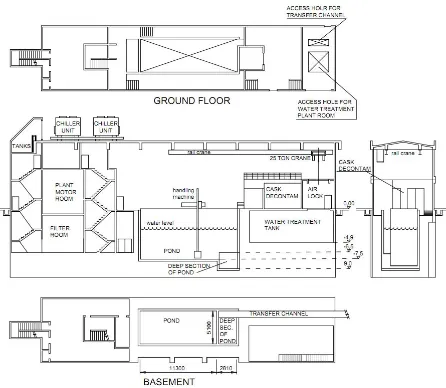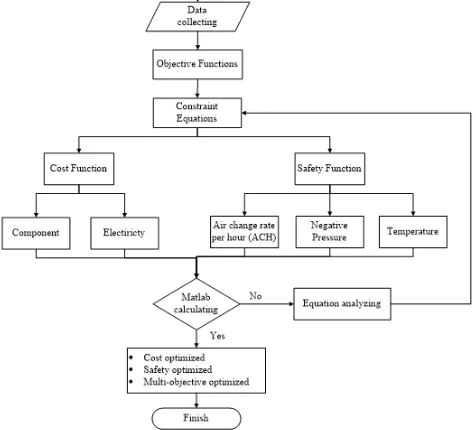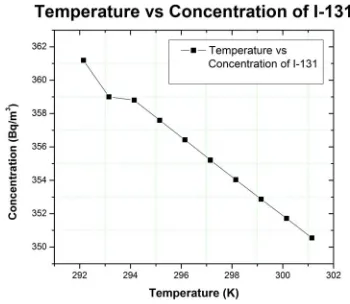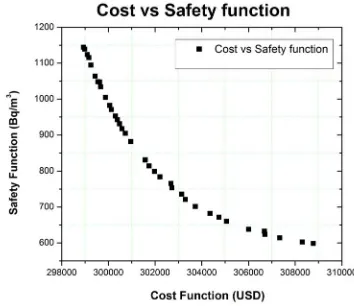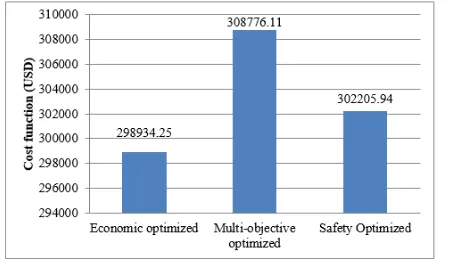Multi-Objective Optimization of Ventilation and Air
Conditioning System at Interim Storage for Spent
Nuclear Fuel
R. Ratiko
11DVUXGGLQ
::XODQGDUL
$5RVLGL
(0DU]XNL
Department of Mechanical Engineering Universitas Indonesia
Depok, Indonesia
[email protected]QDVUXGGLQ#HQJXLDFLGZLQGDZXODQGDUL#HQJXLDFLG
DLQXUURVLGL#HQJXLDFLGHGLPDU]XNL#HQJXLDFLG
Abstract— A multi-objective optimization of ventilation and air conditioning system at Interim Storage for Spent Nuclear Fuel (ISSF) at BATAN, Serpong, Indonesia has been considered. The analysis of this research had obtained the results of three scenarios, economic single-objective, safety single-objective, and multi-objective optimizations. The original Pareto frontier between cost and safety function is determined by implementing multi-objective optimization using genetic algorithm. The cost function of the ventilation and air conditioning system was developed based on the present value of the total cost. The safety function of this system was based on contaminant concentration levels which were obtained by using air change rates, negative pressure, and temperature parameters. The economic and safety results have been obtained for three scenarios of optimized systems. The result shows that the multi-objective method by implementing multi-objective optimization using genetic algorithm satisfies the economic and safety criteria.
Keywords— Multi-objective optimization; ventilation and air conditioning system; Interim Storage for Spent Nuclear Fuel.
NOMENCLATURE
Civ Contaminant concentration from inlet air
velocity (Bq/m3)
Co Total energy cost at the ¿rst year of operation
($/year)
Cov Contaminant concentration from outlet air
velocity (Bq/m3)
Ct Contaminant concentration from room
temperature (Bq/m3)
ECC Equivalent cooling cost ($/kWh)
F Annuity factor
g Gravitational acceleration (m/s2)
gel InÀation rate for electricity cost (%) Hyear Annual operational hours (hour)
i Interest rate (%)
k Number of operation years (year)
ۦ Mass flow rate (kg/s)
Pevap Pressure of evaporator (Pa) Pcond Pressure of condenser (Pa) PVC Present value capital cost ($)
PVCChiller Present value capital cost of chiller ($) PVCAHU
dc
Present value capital cost of Air Handling Unit (AHU) and ducting system ($)
PVCBlower Present value capital cost of blower ($) PVE Present value of electricity cost ($)
PVT Present value of the total cost ($)
Vin Inlet air volume flow from AHU (m3/h) Vout Outlet air volume flow to stack (m3/h) ܥblower in Power consumption of inlet air blower (kW) ܥblower out Power consumption of exhaust air blower (kW)
ܥcomp Compressor power consumption (kW)
ܥcond Condenser power consumption (kW)
ܥevap Evaporator power consumption (kW)
ܥtot Total power consumption of the system (kW)
I. INTRODUCTION
The Interim Storage for Spent Nuclear Fuel (ISSF) building facility at Batan, in Serpong, Indonesia is designed to store the spent nuclear fuel from nuclear research reactors in Indonesia for many more years.
The radioactive gaseous contaminants that could be released from the spent fuel inside the interim storage building in Serpong are Caesium-137 (CS-137), Iodine-131 (I-131), and Xenon-133 (Xe-133). In addition to these Radon-222 (Ra-222), a natural radioactive gas from uranium-radium radioactive decay series, can present itself in the walls of buildings and soil. These gaseous contaminant concentrations can be reduced with ventilation and air conditioning system.
A lot of research is now focusing on optimizing ventilation and air conditioning (VAC) system by combining many variables. Optimization methods include single-objective and multi-objective types. . The multi-objective method had been studied by Sayyaadi [1] in a cooling tower assisted by a vapor compression refrigeration system and by Sanaye [2] in a ventilation and air conditioning system with a focus on the compressor, the condenser, the evaporator, and the axial fans. Thermal and economic parameters were the objective functions in this optimization. The same methods were used by Rezayan [3] for thermoeconomic optimization and as an exergy analysis
of CO2/NH3 cascade refrigeration system for VAC. The
cooling capacity, ambient temperature (ambient) and cold room temperature were the constraints in this optimization. The total annual cost for this system including input exergy cost to the system and initial capital cost of the system was the objective function. Input exergy to the system was the power consumption of compressors and fans and the capital cost.
Jain [4] also applied multi-objective optimization of a vapor compression-absorption cascaded refrigeration system by combining thermodynamics, economic parameters and non-dominated environments using Sort Genetic Algorithm-II (NSGA-II). The same objective function had been studied by Sadeghi [5]. The exergy and economical on waste heat from the exhaust gases of the engine HCCI (homogeneous charge compression ignition) were used to drive the ejector refrigeration system.
A developed ecological function for absorption refrigerators with four-temperature levels had been optimized by Ahmadi [6]. Multi-objective evolutionary approaches (MOEAs) using the NSGA-II method and the frontier of Pareto optimum were applied in this study.
An optimization of the combination cycle for power and cooling cycle using binary organic working fluid had been studied by Abed [7]. Turbine work, cooling capacity, and thermal efficiency were considered as three important conflicting objectives used to find the best combination.
There are still many researches on ventilation and air conditioning system optimization, however an optimization study of the ventilation and air conditioning system at a nuclear facility is still rare. This paper presents ventilation and air conditioning system optimization at the Interim Storage for Spent Fuel (ISSF) building facility in Batan, Serpong, Indonesia with the variation of objective function for cost and safety parameters. The frontier Pareto will be used for selecting
the final results to determine the optimum design for the system.
II. BUILDING DESCRIPTION
The Interim Storage for Spent Fuel (ISSF) building facility as shown in Fig. 1 below was built in Batan, Serpong, Indonesia in 1998. The ISSF building facility is utilized to store the spent fuel from nuclear research reactors in Serpong, Bandung and Yogyakarta. The ISSF building consists of a storage pool area and office area. The spent fuel is stored in the storage pool, which is filled with water. The dimensions of the pool are 14 x 5 meters and 7.5 meter depth (the base pond is 11.2 x 5 meters ) and 9 meter depth (the deep section pond is 2.8 x 5 meter ) from the ground floor to the basement as shown in Fig. 2 below.
Based on design documents, the ISSF facility can accommodate spent fuel discharged from 25 years of Serpong reactor operations. The maximum storage capacity is 1448 spent fuel elements including the spent element control rod [8].
Fig. 1. Interim Storage for Spent Fuel building in Batan
Fig. 2. Design of Interim Storage for spent nuclear fuel in Batan
classified into three zones. Each zone has a different negative pressure. The negative pressure is highest in the zone with high potential radioactive contamination.
III. REFRIGERATION AND VACSYSTEM SPECIFICATION
A chiller with 213.6 kW (60.7 TR) cooling capacity is provided to maintain the pool water temperature and the room temperature inside the ISSF building. A reciprocating compressor drives the system with R-22 as refrigerant. The condenser is a shell and tube heat exchanger. The evaporator is also a shell and tube heat exchanger with the refrigerant placed on the shell side and water on the tube side. The cooled water from the evaporator is streamed into the air handling cooling coil.
IV. METHODOLOGY
This study examines a multi-objective optimization of ventilation and air conditioning system at Interim Storage for Spent Nuclear Fuel (ISSF) at BATAN, Serpong. The objective functions of this research are cost and safety of the system. The flow diagram of the research method can be seen in Fig. 3.
Fig. 3. Flowchart diagram of research process
V. OBJECTIVE FUNCTION
Cost Function
The cost function in this study is the equivalent cooling cost (ECC). The ECC consists of the capital investment and electricity costs of the whole system. Electricity cost has to be expressed as a function of the power consumption of the whole system. The total power of the system can be determined from the power required of each component such as the compressor and blower in air handling.
ECC = F.PVT (1)
F = i / (1 - (1 + i)-k ) (2)
The present value of the total cost called as PVT is stated below:
PVT = PVC + PVE (3)
The initial cost of the chiller package, air handling unit (AHU) and ducting system are included into the present value capital cost (PVC).
PVC =PVCChiller +PVCAHU dc (4)
The operational cost is the electricity cost for the compressor, evaporator pump, blower for condenser and blower for AHU. Thus, the operation cost will be focused on the present value of electricity cost (PVE) for those components. The inflation rate in each year of the annual electricity cost will increase non-uniformly, this issue has to be predicted and calculated using the formula as below:
PVE = C0 / (i-gel ) [1 - ((1+i) / (1+gel ))k ] (5)
The total electricity cost at the first year of operation comprises the price of electricity for each kWh (Cel), the annual
operation hours, and the total power consumption of the system (ٷtot). The formula is stated as below:
C0 = Cel.Hyear.ٷtot (6)
Total Power Consumption
Total power consumption of the system can be obtained using the formulas as written below:
ٷtot = ٷcomp + ٷevap + ٷcond + ٷblower in + ٷblower out (7)
The compressor power consumption can be calculated using Matlab Software connected with Refprop software to calculate the thermodynamic properties of the refrigerant. After the values of the refrigerant enthalpy are determined, then the total power consumption of the compressor can be calculated using mass flow rate.
The total cooling load has to be determined for calculating the mass flow rate. The building is modelled using Sketch-up, then the weather data for one year in Serpong is calculated using Energy plus. The result of its calculation showed the average cooling is 142.04 kW. In addition to this, the spent nuclear fuel still produces heat which has a cooling load of around 6 kW. Thus, the total cooling load used in the calculation of mass flow is 148 kW.
Power consumption of the evaporator, condenser, blower in and blower out can be calculated from break horse power (BHP) of the blower motor power as in the formula stated below:
BHP = WHP / Șblower motor (8)
Safety Function
Besides the cost function the safety function is another objective in this study. As this building is to function as Interim Storage for Spent Nuclear Fuel in Batan, safety is of paramount importance in this area.
have to be considered in safety criteria. Air change rate and negative pressure are more influential than the other two.
Caesium-137, Iodine-131, Radon-222, and Xenon-133 are the contaminants that need to be considered in this research. Those four types of contaminants are analyzed using multi-zone airflow and contaminant transport software, Contam.
From the analysis, it is known that the concentration of Iodine-131 decreases slower than the other three contaminants due to its density being greater than the others. Thus, Iodine-131 is chosen to represent air change rate, negative pressure and temperature analysis. Based on an effective dose limit of 20 mSv in a year, standard breathing rate and a maximum average occupation of ISSF building of 500 h per year, the concentration limit of radioiodine–131 in air can be calculated with a value of 1666.67 Bq/m3 [9,10].
The objective function of safety can be stated as below:
Safety = Civ + Cov + Ct (9)
Air Change Rates
Air change rates greatly affect the contaminant concentration in the building. The result of concentration analysis of Iodine-131 to the effects of air change rates (air volumetric flow) using CONTAM is shown as Fig. 4.
Fig. 4 shows that the concentration level of Iodine-131 decreases with an increase of volumetric flow. By using these data, Matlab software with curve fitting method can obtain the equation as written below:
Civ = 935.84.e-2E-4*Vin (10)
Fig. 4. Concentration of Iodine-131 [Bq/m3] vs. air change rates
Negative Pressure
The second parameter that also affects the concentration level of contaminants in the building is the negative pressure. Using CONTAM software, the effect of the negative pressure on contaminant concentration would be analyzed. The result is plotted and shown as Fig. 5.
Fig. 5. Concentration of Iodine-131 [Bq/m3] vs. negative pressure
Fig. 5 above shows that the concentration level of Iodine-131 decreases with an increase of negative pressure. Using the curve fitting, the equation is stated below:
Cov = -9.141x10-11Vout4 + 1.909x10-6Vout3 -0.01494Vout2 +
51.82Vout - 6.684x104 (11)
Temperature
The third parameter that affects the concentration level of contaminants in the building is temperature. The result diagram is shown in Fig. 6 below.
Fig. 6. Concentration of Iodine-131 [Bq/m3] vs. temperature
The fitting equation of the above diagram is:
Ct = -1.1402x106Vcond + 693.99 (12)
Decision Variables
Seven variables are chosen as decision variables in this study. Those variables are as described in the list below:
Tcond : Condensing temperature (K)
Tevap : Evaporating temperature (K) ¨TSub : Subcooling temperature (K) ¨TSup : Superheating temperature (K)
Vin : Inlet air volumetric flow from AHU (m3/h)
Vout : Outlet air volumetric flow to stack (m3/h)
VI. RESULTS AND DISCUSSION
The optimization procedure and flowchart of cost function calculation by implementing multi-objective optimization using Genetic Algorithm is presented in Fig. 7. While, the optimization procedure and flowchart of safety function calculation by implementing multi-objective optimization using Genetic Algorithm is presented in Fig. 8.
An approach method using multiple criteria in the decision making process for optimization of problems which involve more than one objective to be optimized simultaneously is called a multi-objective optimization. Each objective at the ideal point is optimized with maximum value regardless of the satisfaction of other objectives likewise each objective at nadir point reaches minimum value. The Pareto frontier gives a trade-off solution between obtained solutions of various chosen objectives. [10].
Genetic algorithm method is used to obtain the eight decision variables (Tcond, Tevap, ¨TSub, ¨TSup, Vin, Vout, Troom)
and five constraint equations (Eq. (7) – (12)). Based on the number of decision variables and the number of constraint equations, then the results will be plotted in to the Pareto frontier.
Fig. 7. The optimal design procedure for cost function
Fig. 8. The optimal design procedure for safety function
Single-objective optimization thermodynamics, economics single-objective optimization, and multi-objective of the combined objective had been considered as three optimized systems.
Fig. 9 is the result of the multi-objective optimization scenario, where the data is plotted on the Pareto frontier diagram. The x-axis is the first objective function which is the cost function. The y-axis is the second objective function or safety function. In deciding the multi-objective optimization, it needs a process for deciding the optimized scenario.
Fig. 9. Pareto frontier result
The next process is to select an ultimate optimum output data from the results. Below is the result of three scenarios for economic optimization, safety optimization, and multi-objective optimization. The following results are seven decision variables in various scenarios:
Table 1. The values of decision variables in the various optimization scenarios.
Decision Variables
Economic Optimized
Safety Optimized
Multi-objective Optimized
Tcond (K) 303.15 306.07 303.41
Tevap (K) 285.15 284.28 285.08
ǻTsub (K) 10.00 9.86 9.98
ǻTsup (K) 3.42 9.92 5.64
Vin (m3/h) 2621.14 14055.86 6861.18
Vout (m3/h) 5131.95 5498.91 5419.08
Troom (K) 306.53 310.15 308.34
Table 1 indicates the value of decision variables obtained for three scenarios including economic optimized, safety optimized, and multi-objective optimized.
Table 2. The results of the energy analysis of various designs
Economic Optimized
Safety Optimized
Multi-objective Optimized
ܥcomp (kW) 12.59 15.85 12.90
ܥblower in (kW) 3.37 18.07 8.82
ܥblower out (kW) 6.60 7.07 6.97
Civ (Bq/m3) 560.73 59.20 233.72 Cov (Bq/m3) 239.11 199.13 207.88
Table 2 indicates the value of energy analysis for various designs including economic optimized, safety optimized, and multi-objective optimized. Some useful data are listed in this table.
Fig. 10 indicates the result of economic analysis of three scenarios. It explains that the minimum present value of total cost for the system belongs to the economic optimized system.
Fig. 11 indicates the result of economic analysis of three scenarios. It explains that the minimum concentration of contaminants belong to the safety optimized system.
Fig. 10. Comparison of cost in different optimization scenarios
Fig. 11. Comparison of safety in different optimization scenarios
Fig. 10 clearly shows that low cost is attained in the single-objective of economic optimized. However, as seen in Fig. 11, the contaminant concentration is higher than the safety optimized method, although still below the limit of 1666.67 Bq/m3. But, if the concentration of contaminant needs to be
reduced into the very safe limits, the cost will be higher. By applying multi-objective optimized, middle values can be attained whereby the cost is not so high and there is relatively low contaminant concentration.
VII. CONCLUSION
The three optimization scenarios in this study are economic single-objective, safety single-objective, and multi-objective of cost and safety objective. The cost function of the VAC system was developed based on the present value of the total cost (PVT). The safety function of this system was built based on
the level of contaminant concentration which is affected by air change rates, negative pressure, and temperature.
The configuration of the optimization was developed with seven decision variables and five constraint equations. The multi-objective optimization was developed from single objective optimization of cost and safety simultaneously. The final result of multi-objective optimization was decided to attain the optimum cost and safety. The economic optimization is focused on limitation of power consumption on the system. Whereas, the safety function is considered by the limitation of concentration levels of contaminants. However, the multi-objective optimization is concerned with limited power consumption and limitation of contaminant concentration levels.
The result in Fig. 10 shows that the present value of total cost obtained for the multi-objective optimization is USD 302.205,94 for fifteen years of operation. And the concentration level of contaminants can be reduced into784.03 Bq/m3. It was concluded that the multi-objective method by
implementing multi-objective optimization using Genetic Algorithm satisfies the economic and safety criteria.
REFERENCES
[1] Sayyaadi, H. and M. Nejatolahi, Multi-objective optimization of a cooling tower assisted vapor compression refrigeration system. International Journal of Refrigeration, 2011. 34(1): p. 243-256.G. Eason, B. Noble, and I.N. Sneddon, “On certain integrals of Lipschitz-Hankel type involving products of Bessel functions,” Phil. Trans. Roy. Soc. London, vol. A247, pp. 529-551, April 1955. (references)
[2] Sanaye, S. and H.R. Malekmohammadi, Thermal and economical optimization of air conditioning units with vapor compression refrigeration system. Applied Thermal Engineering, 2004. 24(13): p. 1807-1825.
[3] Rezayan, O. and A. Behbahaninia, Thermoeconomic optimization and exergy analysis of CO2/NH3 cascade refrigeration systems. Energy, 2011. 36(2): p. 888-895.
[4] Jain, V., et al., Thermo-economic and environmental analyses based multi-objective optimization of vapor compression–absorption cascaded refrigeration system using NSGA-II technique. Energy Conversion and Management, 2016. 113: p. 230-242.
[5] Sadeghi, M., S.M.S. Mahmoudi, and R. Khoshbakhti Saray, Exergoeconomic analysis and multi-objective optimization of an ejector refrigeration cycle powered by an internal combustion (HCCI) engine. Energy Conversion and Management, 2015. 96: p. 403-417.
[6] Ahmadi, M.H., et al., Thermodynamic and thermo-economic analysis and optimization of performance of irreversible four-temperature-level absorption refrigeration. Energy Conversion and Management, 2014. 88: p. 1051-1059.
[7] Abed, H., et al., Thermodynamic optimization of combined power and refrigeration cycle using binary organic working fluid. International Journal of Refrigeration, 2013. 36(8): p. 2160-2168.
[8] Design of interim storage for spent fuel (ISSF), BATAN, Serpong. National Nuclear Energy Agency. 1996.
[9] INTERNATIONAL ATOMIC ENERGY AGENCY. A basic toxicity classification of radionuclides. Techical report series 15. Vienna: IAEA; 1963.
[10] Jiemwutthisak, P., et al., Air Monitoring to Control the Intake of Airborne Radioiodine-131 Contaminants by Nuclear Medicine Workers. [11] Kumar, R., et al., Multi-objective thermodynamic optimization of an
